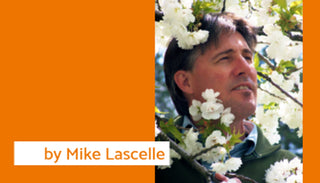The common name Winter Camellia leaves most of us with visions of blooms unfurling while the snow is falling, and while this is a possibility with some varieties, many actually start flowering in early fall. Case in point, we just had some Camellia ‘Kanjiro’ begin blooming in the nursery just two weeks after the autumn equinox. The other misrepresentation here is the commonly used species name, Camellia sasanqua, which often overlooks the fact that many of these are complex hybrids such as Camellia x vernalis (a sasanqua x japonica cross) or Camellia hiemalis cultivars. You also have to remember that many winter camellia varieties are hundreds of years old, having been cultivated in Japanese gardens since the Edo period in the late 1600’s.
Of course, most of you are not really concerned about their proper botanical name or breeding, as you just want beautiful cold-weather flowers for your garden. With winter camellias you get brilliant bloom colours of white, pink, deep rose, bicolour or even a few true reds, with flower forms that range from single, semi-double, anemone or fully double, often with beautifully contrasting golden stamens. Many like ‘Hana Jiman’ emit a delightful fragrance (jasmine, rose and citrus) on warmer days and the overwintering Anna’s Hummingbirds are always hovering over them, looking for some fresh nectar.
Winter Camellias are also as hardy as the more common Japanese species, tolerating temperatures down to USDA zones 6 and 7. With flowers sizes ranging between 2-4” across, they are a bit smaller than most but they more than make up for this by being quite floriferous once mature. While most varieties have a lax growth habit (with the exception of ‘Yuletide’) with long, outstretched branches, this makes them ideal for growing flat against a fence or in a container espaliered to a trellis, as they will bloom nicely along the foliage contour. In either case, given their unusual bloom time, hummingbird potential and sheer beauty, these evergreen shrubs really deserve a place in your garden. With that in mind, here are some common varieties to choose from.
‘Apple Blossom’
This RHS Award of Garden Merit winner produces large 4” wide single blooms of white, delicately edged in pink. The flowers are lightly fragrant with a floral scent and are nicely contrasted by the golden stamens. Grows 8-10’ tall. Hardy to USDA zone 7.

(📸 MK Lascelle)
‘Chansonette’
A compact winter camellia with fully double lavender-pink flowers borne over a long period, from October to January. This broadleaf evergreen shrub is ideal for a part sun to an open shade exposure. Grows 3-4’ tall. Hardy to USDA zone 7.

(📸 MK Lascelle)
‘Hana Jiman’
This variety is often mistaken for ‘Apple Blossom’ as the blooms are quite similar in nature and both are fragrant. The flowers of this variety range in form from single to semi-double and its blooms slightly later than ‘Apple Blossom’. Grows 6-10’ tall. Hardy to USDA zone 7.

(📸 MK Lascelle)
‘Kanjiro’
A long-blooming (October to January) winter camellia with bright semi-double flowers of an intense cerise pink that contrast well against the deep green foliage. These are slightly fragrant on warmer days and borne in abundance. Grows 8-10’ tall. Hardy to USDA zone 7.

(📸 MK Lascelle)
‘Just Chill Double Pink’
You know winter camellias have really become trendy, once Proven Winners start introducing their own varieties. This cultivar features fully double pink peony-like blooms that start to emerge mid-autumn. Grows 5-8’ tall. Hardy to USDA zone 6.

(📸 Proven Winners)
‘Just Chill Red Tip’
This is a real foliage breakthrough for winter camellias, as the new growth in both spring and fall is a glossy burgundy red. The single mid pink flowers (with contrasting gold stamens) emerge in the fall contrasting the new growth quite nicely. Grows 5-8’ tall. Hardy to USDA zone 6.

(📸 Proven Winners)
‘Otome’
Also known as ‘Otome-sazanka’, this old Japanese selection begins blooming in November, with an abundance of 3” wide semi-double shell pink blooms. It is also reasonably compact, growing wider than tall when left without pruning. Grows 3-5’ tall. Hardy to USDA zone 7.

(📸 MK Lascelle)
‘Setsugekka’
A good alternative for the harder-to-find ‘White Doves’, as the pristine white semi-double blooms literally glow in the dark on those dull winter days. Flowering from mid-autumn to December, these are also delightfully fragrant in warmer weather and bound to attract the overwintering hummingbirds. Grows 8-10’ tall. Hardy to USDA zone 7.

(📸 MK Lascelle)
‘Showa-no-Sakae’
This older variety was introduced just after WW2 and has a name that translates as ‘glory of the new era’. It is quite compact in growth habit and features scented mid-pink semi-double flowers from November to February. Grows 4-6’ tall. Hardy to USDA zone 7.

(📸 MK Lascelle)
‘White Doves’
An older and hard-to-find cultivar which had already earned the RHS Award of Garden Merit way back in 1964. Its Japanese name (‘Mine-no-Yuki’) translates as ‘snow on the mountain’ and aptly describes the pristine white semi-double blooms which are also fragrant. Grows 4-6’ tall. Hardy to USDA zone 7.

(📸 MK Lascelle)
‘Yuletide’
I saved the best for last as this top-selling cultivar sports single true red blooms beautifully contrasted with golden stamens just around the holiday season. Its compact, upright growth habit makes it ideal for those Christmas planters right by the front entrance. Grows 6-8’ tall. Hardy to USDA zone 7.

(📸 MK Lascelle)
Please keep in mind that I don’t currently have all of these varieties in stock, as the wholesale supply is sporadic at best, but we still have a great selection of winter camellias waiting for you at Amsterdam Garden Centre.
Copyright 2025 MK Lascelle


